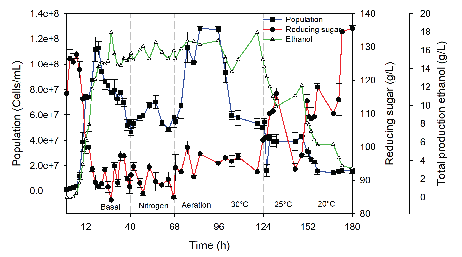 |
|
Volatile esters are formed during alcoholic fermentation, particularly that performed by yeasts. These compounds confer fruity attributes to drinks. Fermented beverages contain namely two groups of esters: acetate esters formed by alcohol acetyltransferase enzymes (Atf1 and Atf2) and ethyl esters produced by the acyl-CoA ethanol O-acyltransferase enzymes (Eht1 and Eeb1), encoded by the ATF1, ATF2, EHT1 and EEB1 genes. The purpose of this study was to evaluate the effect of nitrogen addition, aeration and low temperatures on ester production during fermentation on Agave tequilana juice in a continuous system. Low temperatures increased ethyl esters production (4.5-fold) and enhanced the expression of the involved genes (more than 3.5-fold). Conversely, when compared to aeration, the effect was negative as esters production decreased (75%) whereas the ATF1, ATF2 and EHT1 genes were repressed (0.6-, 0.8- and 0.4-fold, respectively). The results obtained during a continuous cultivation on Agave tequilana juice showed that production of esters occurred concomitantly with an increased gene expression, except for ethyl acetate. Therefore, the studied genes are not the only ones involved in its synthesis.
Keywords: S. cerevisiae, gene expression, Esters, Agave tequilana, continuous culture.
|
|
 |

